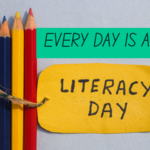There would be little disagreement on the importance of broadening and deepening the vocabulary of young people. In the preface to Teaching effective vocabulary , the 2008 Chief Adviser on School Standards in the UK, Sue Hackman, compares having a good vocabulary to ‘an artist’s palette of colours’.
Vocabulary is more than a list of words, and although the size of one’s vocabulary matters, it’s knowing how to use it which matters most. The best comparison is to an artist’s palette of colours which can be mixed and applied to create powerful effects.
Why then isn’t drama the centre of literacy programs in our schools?
Data on the connection of drama and other arts forms and literacy is evident from research by the American National Endowment for the Arts’ The Arts and Achievement in At-Risk Youth: Findings from Four Longitudinal Studies (March, 2012) which shows that students who received an arts-rich education read more newspapers, books and visit more libraries than their arts-deprived counterparts.
… low-SES youth with arts-rich backgrounds were more likely than their less-arts-involved counterparts to read newspapers or participate in high school yearbook or newspaper production. But the NELS:88 database includes two other indicators of literary involvement: book reading and library visits. According to this database, 26-year-olds from low-SES backgrounds who had engaged with the arts intensely from middle school through high school were more likely than the low-arts, low-SES group to have done either literary activity. Eighty-two percent of the high-arts, low-SES group read at least one book in the preceding year (1999-2000). This was roughly the same share of book readers as in the overall study population (81 percent), and it was higher than the corresponding share of the low-arts, low-SES group (74 percent). Regarding library visits, 55 percent of the high-arts, low-SES group in the database did this activity at least once in the past year, compared with 48 percent of the overall sample and 43 percent of the low-arts, low-SES group.
Possible explanations
However, as Patrice Baldwin and Kate Flemings’ Teaching Literacy Through Drama:Creative Approaches (2003, 2005 & 2007) show, teachers are reluctant to use methodologies in which they have little training. This is despite the overwhelming evidence that drama methods develop students
- socially (working in and out of role together to create and communicate shared understandings and meanings);
- intellectually ( thinking in and out of role);
- physically (enacting);
- emotionally (feeling, personally responding and empathising in and out of role);
- morally (linking thought, action and consequence);
- spiritually (enduring personal insights); and
- culturally (recognising and valuing diversity).
In short, the problem is that many teachers lack confidence and expertise to plan and deliver drama lessons because of
… the lack of professional development opportunities and limited initial teacher education opportunities for this in recent years.
Could the same be said of the classroom teachers use of vocabulary games within an already ‘crowded curriculum’?
Accordingly, dietitians point out that all diets work but that once you cease dieting the bad eating habits return. However, if you really enjoy and learn the recipes and follow its proportions, the likelihood is that you will internalise the practice of good eating habits through your love of the food you create.
Sydney Theatre Company’s School Drama
It is for similar reasons that I understand the benefits of programs delivered by New York Lincoln Centre’s Aesthetic Institute and the Sydney Theatre Company’s School Drama™ initiative. Introduced in 2009 under the initiative of Professor Robyn Ewing of the University of Sydney the program was trialled for two years and then launched in 2011 with eighteen schools working with six ‘teaching artists’. In “Using Drama To Enhance Literacy: The School Drama Initiative”, Ewing et al. conclude that the program’s initial findings appeared to show that
Over both completed years of the project the participant teachers reported a range of positive outcomes enabled by the implementation of drama strategies in their classroom English program. Participant teachers also believe that the in-classroom professional learning that occurs during SD develops their confidence to use drama strategies as effective tools for learning and teaching particularly in English and literacy but in addition more generally across the curriculum. Despite the short time frame, it is their belief that student literacy outcomes are enhanced.
In the same year, Professor Ewing co-authored Transforming the Curriculum through the Arts (2011) with Associate Professor Robyn Gibson. Their rationale for the book is that an education in the Arts ensures that there is a deepening of meaning through
- the discovery of richer perspectives;
- the exploration of relationships; and
- rigorous and critical attention to things that matter to us.
Like Professor Ewing, I am passionate about finding effective pedagogical approaches in the complex and crowded primary curriculum. I look forward to sharing my thoughts with readers in this blog. Meanwhile, check out the STC’s website and Robyn Ewing’s research and writing.







